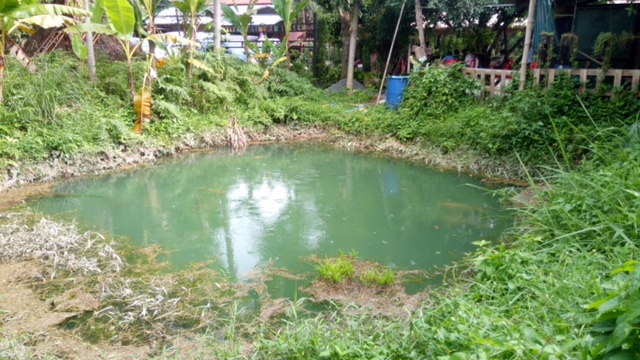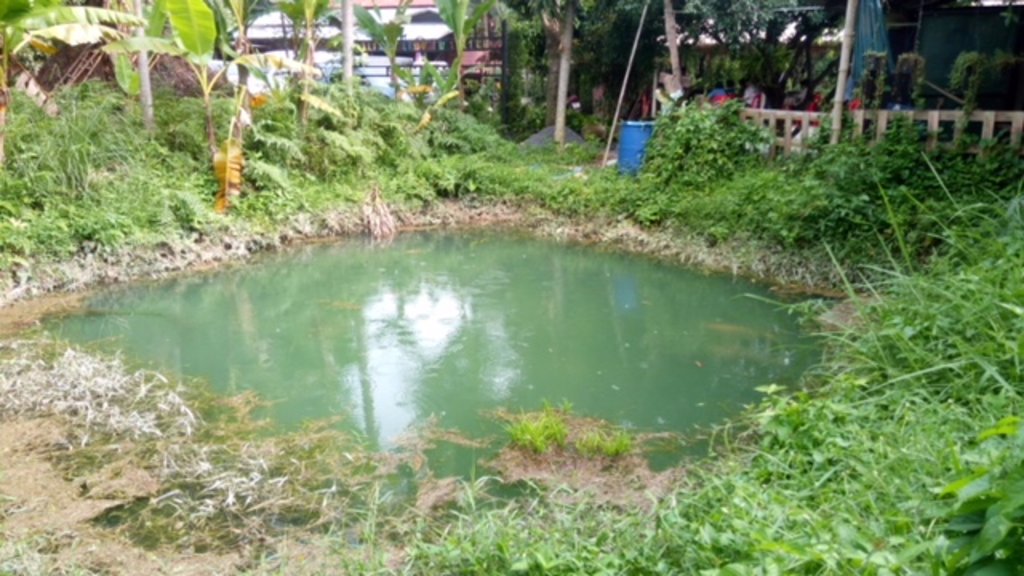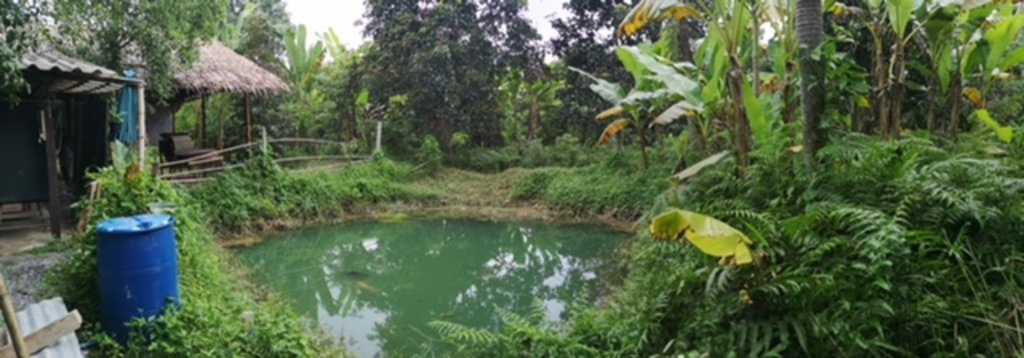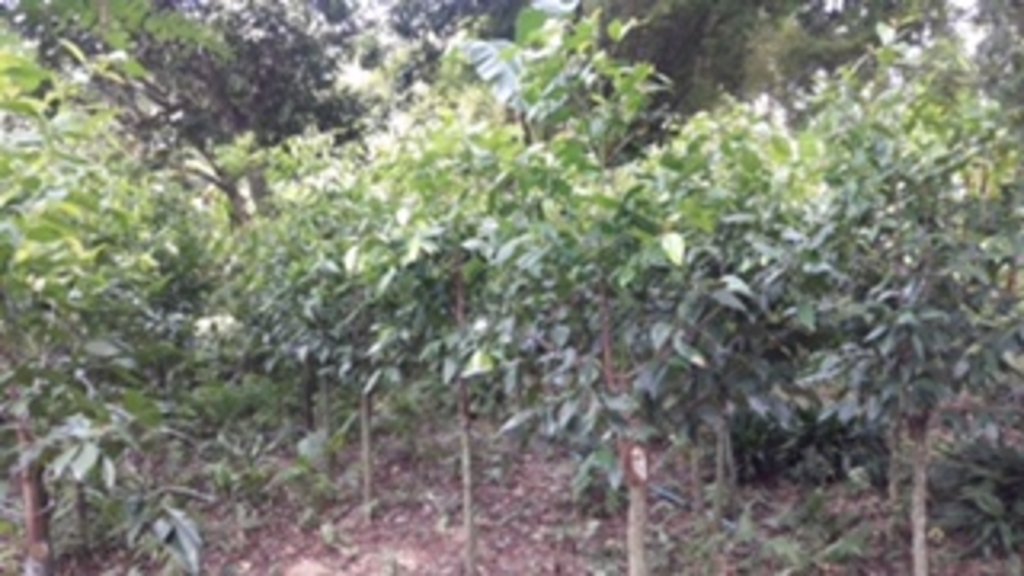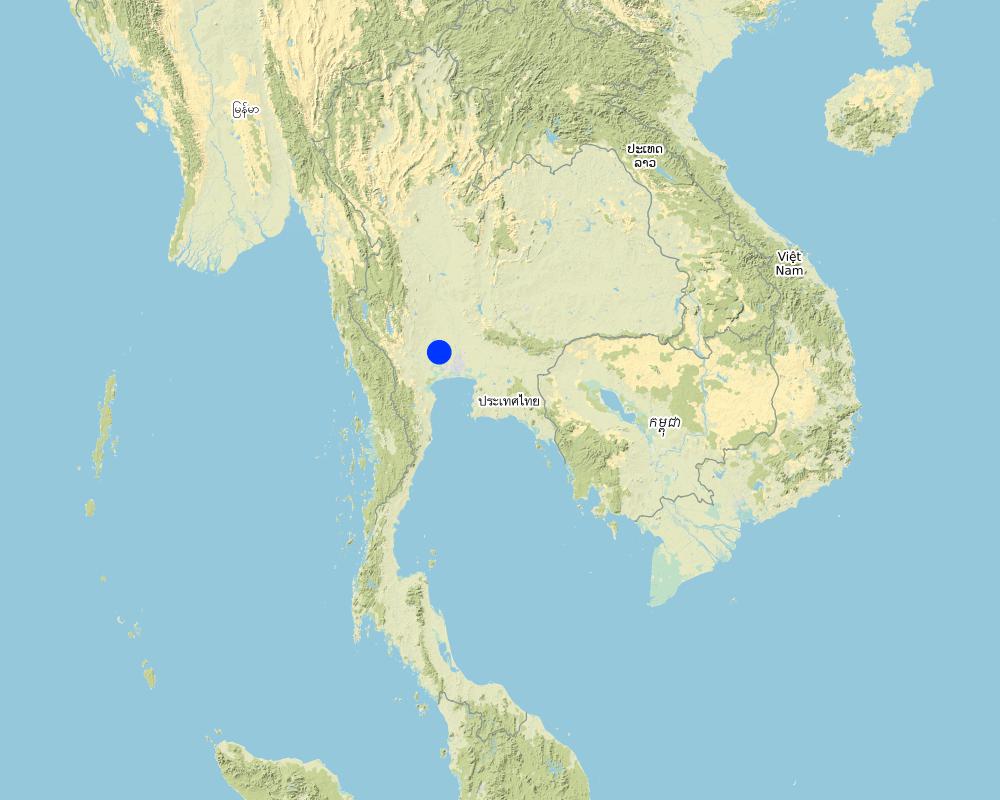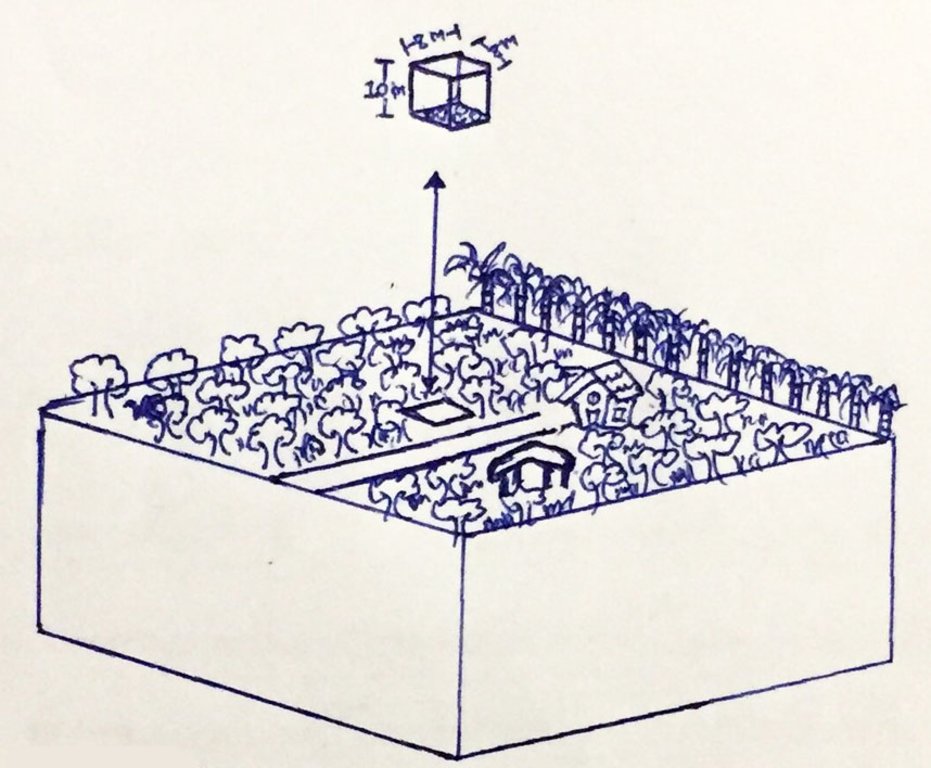Water Storage Ponds in Small-Scale Agricultural Areas [泰国]
- 创建:
- 更新:
- 编制者: Bunjirtluk Jintaridth
- 编辑者: –
- 审查者: Rima Mekdaschi Studer, Pitayakon Limtong, William Critchley
Bo Bao Kanomkrok
technologies_4123 - 泰国
查看章节
全部展开 全部收起1. 一般信息
1.2 参与该技术评估和文件编制的资源人员和机构的联系方式
关键资源人
SLM专业人员:
Suriyawongpongsa Munthana
Nakornnayok Station, Land Development Department (Regional 1)
泰国
SLM专业人员:
Jintaridth Bunjirtluk
Land Development Department
泰国
SLM专业人员:
Na Lampang Ratikorn
Land Development Department
泰国
土地使用者:
Ketkaew Sommai
Tung Kra Prong Study Center
泰国
1.3 关于使用通过WOCAT记录的数据的条件
编制者和关键资源人员接受有关使用通过WOCAT记录数据的条件。:
是
1.4 所述技术的可持续性声明
这里所描述的技术在土地退化方面是否存在问题,导致无法被认为是一种可持续的土地管理技术?:
否
2. SLM技术的说明
2.1 技术简介
技术定义:
"Bo Bao Kanomkrok" is a storage pond excavated as a source of water for agricultural purposes. It is shaped in the form of a rectangle to store water in the rainy season and thus to be a source of water in the dry season.
2.2 技术的详细说明
说明:
A water storage facility or "Bo Bao Kanomkrok" is a pond excavated as a source of water for agricultural purposes in the dry season. It is dug in a form of rectangle to store water during the rains and thus to prevent water from drying up in the area. It increases agricultural activities in the dry season. Bo Bao Kanomkrok is excavated in a farmer's agricultural land to a dimension of 8 meters wide, 8 meters long and 10 meters deep. It has a capacity of 640 m3 which is appropriate for an agricultural area of about 6 rai. Water in the storage "bank" is available through the dry season. To establish it, the pond is dug vertically with no side-slopes. After the pond is completed, muddy soil is coated around the bottom and sides to prevent water from seeping out. Plants are grown around the edge of the pond to prevent collapse. Therefore, Bo Bao Kanomkrok is an appropriate low cost option for providing stored water to crops on a small-scale. It is a good prototype for extending to other agricultural plots in the community and adjacent communities. In the small-scale agricultural areas there are fruit-bearing trees, perennial crops and vegetables such as sweet yellow marian plums, durians, santols, hairy-leafed apitongs, Barking Deer's Mango, hedge bamboo, Paco fern, bananas, Garcinia cowa, Brazilian Pepper-tree, etc. Bo Bao Kanomkrok must be maintained by the owner so that it will be efficient in storing water throughout the year.
Ban Thung Krapong Learning Center, Nakhon Nayok province is the prototype for communities to learning to solve problems by themselves, by studying from nature and the environment in the community.
2.3 技术照片
2.5 已应用该技术的、本评估所涵盖的国家/地区/地点
国家:
泰国
区域/州/省:
Nakhon Nayok
有关地点的进一步说明:
Ban Thung Krapong Learning Center, Nakhon Nayok province
具体说明该技术的分布:
- 均匀地分布在一个区域
如果不知道精确的区域,请注明大致覆盖的区域:
- 1-10 平方千米
Map
×2.6 实施日期
注明实施年份:
87
如果不知道确切的年份,请说明大概的日期:
- 10-50年前
2.7 技术介绍
详细说明该技术是如何引入的:
- 通过土地使用者的创新
注释(项目类型等):
Study this technology from Khao Hin Son Royal Development Center
3. SLM技术的分类
3.1 该技术的主要目的
- 改良生产
- 保持/提高生物多样性
- 降低灾害风险
- 适应气候变化/极端天气及其影响
- 创造有益的经济影响
3.2 应用该技术的当前土地利用类型
同一土地单元内混合使用的土地::
是
具体说明混合土地使用(作物/放牧/树木):
- 农林业

农田
- 一年一作
每年的生长季节数:
- 1
采用间作制度了吗?:
是
采用轮作制度了吗?:
是
注释:
Annual cropping
3.4 供水
该技术所应用土地的供水:
- 雨养
3.5 该技术所属的SLM组
- 集水
3.6 包含该技术的可持续土地管理措施

结构措施
- S7:集水/供水/灌溉设备
3.7 该技术强调的主要土地退化类型

土壤水蚀
- Wo:场外劣化效应
注释:
In long term, they were found that there are accumulation from sediments inside the pond. Therefore, we have to dig out from them.
3.8 防止、减少或恢复土地退化
具体数量名该技术与土地退化有关的目标:
- 防止土地退化
- 减少土地退化
4. 技术规范、实施活动、投入和成本
4.1 该技术的技术图纸
4.2 有关投入和成本计算的一般信息
具体说明成本和投入是如何计算的:
- 每个技术区域
注明尺寸和面积单位:
6 rais
如相关,注明美元与当地货币的汇率(例如1美元=79.9巴西雷亚尔):1美元=:
32.0
注明雇用劳工的每日平均工资成本:
300 Baht per day
4.3 技术建立活动
| 活动 | 时间(季度) | |
|---|---|---|
| 1. | Labour cost | Before onset of rains |
| 2. | Backhoe | Before onset of rains |
4.4 技术建立所需要的费用和投入
| 对投入进行具体说明 | 单位 | 数量 | 单位成本 | 每项投入的总成本 | 土地使用者承担的成本% | |
|---|---|---|---|---|---|---|
| 劳动力 | labour cost for digging sediments out from well | head | 4.0 | 300.0 | 1200.0 | 100.0 |
| 劳动力 | Labour for driving Backhoe | hours | 3.0 | 1200.0 | 3600.0 | 100.0 |
| 技术建立所需总成本 | 4800.0 | |||||
| 技术建立总成本,美元 | 150.0 | |||||
4.5 维护/经常性活动
| 活动 | 时间/频率 | |
|---|---|---|
| 1. | In long term,sediments accumulation inside the well. Therefore, we have to dig out from them. | once per 10 years |
4.6 维护/经常性活动所需要的费用和投入(每年)
| 对投入进行具体说明 | 单位 | 数量 | 单位成本 | 每项投入的总成本 | 土地使用者承担的成本% | |
|---|---|---|---|---|---|---|
| 设备 | Backhoe | hour | 1.0 | 1200.0 | 1200.0 | 100.0 |
| 技术维护所需总成本 | 1200.0 | |||||
| 技术维护总成本,美元 | 37.5 | |||||
4.7 影响成本的最重要因素
描述影响成本的最决定性因素:
The amount of sediment
5. 自然和人文环境
5.1 气候
年降雨量
- < 250毫米
- 251-500毫米
- 501-750毫米
- 751-1,000毫米
- 1,001-1,500毫米
- 1,501-2,000毫米
- 2,001-3,000毫米
- 3,001-4,000毫米
- > 4,000毫米
指定年平均降雨量(若已知),单位为mm:
1500.00
有关降雨的规范/注释:
Rainfall season is between May to October and Heavy rainfall is during August and September
注明所考虑的参考气象站名称:
Nakhon Nayok Meteorological Station
农业气候带
- 半湿润
5.2 地形
平均坡度:
- 水平(0-2%)
- 缓降(3-5%)
- 平缓(6-10%)
- 滚坡(11-15%)
- 崎岖(16-30%)
- 陡峭(31-60%)
- 非常陡峭(>60%)
地形:
- 高原/平原
- 山脊
- 山坡
- 山地斜坡
- 麓坡
- 谷底
垂直分布带:
- 0-100 m a.s.l.
- 101-500 m a.s.l.
- 501-1,000 m a.s.l.
- 1,001-1,500 m a.s.l.
- 1,501-2,000 m a.s.l.
- 2,001-2,500 m a.s.l.
- 2,501-3,000 m a.s.l.
- 3,001-4,000 m a.s.l.
- > 4,000 m a.s.l.
5.3 土壤
平均土层深度:
- 非常浅(0-20厘米)
- 浅(21-50厘米)
- 中等深度(51-80厘米)
- 深(81-120厘米)
- 非常深(> 120厘米)
土壤质地(表土):
- 中粒(壤土、粉土)
土壤质地(地表以下> 20厘米):
- 中粒(壤土、粉土)
表土有机质:
- 高(>3%)
5.4 水资源可用性和质量
地下水位表:
5-50米
地表水的可用性:
好
水质(未处理):
仅供农业使用(灌溉)
水的盐度有问题吗?:
是
该区域正在发生洪水吗?:
是
规律性:
频繁
5.5 生物多样性
物种多样性:
- 中等
栖息地多样性:
- 中等
关于生物多样性的注释和进一步规范:
Variety of plants
5.6 应用该技术的土地使用者的特征
定栖或游牧:
- 定栖的
生产系统的市场定位:
- 混合(生计/商业)
非农收入:
- > 收入的50%
相对财富水平:
- 平均水平
个人或集体:
- 个人/家庭
机械化水平:
- 手工作业
性别:
- 男人
土地使用者的年龄:
- 中年人
5.7 应用该技术的土地使用者使用的平均土地面积
- < 0.5 公顷
- 0.5-1 公顷
- 1-2 公顷
- 2-5公顷
- 5-15公顷
- 15-50公顷
- 50-100公顷
- 100-500公顷
- 500-1,000公顷
- 1,000-10,000公顷
- > 10,000公顷
这被认为是小规模、中规模还是大规模的(参照当地实际情况)?:
- 小规模的
5.8 土地所有权、土地使用权和水使用权
土地所有权:
- 个人,有命名
土地使用权:
- 个人
用水权:
- 个人
5.9 进入服务和基础设施的通道
健康:
- 贫瘠
- 适度的
- 好
教育:
- 贫瘠
- 适度的
- 好
技术援助:
- 贫瘠
- 适度的
- 好
就业(例如非农):
- 贫瘠
- 适度的
- 好
市场:
- 贫瘠
- 适度的
- 好
能源:
- 贫瘠
- 适度的
- 好
道路和交通:
- 贫瘠
- 适度的
- 好
饮用水和卫生设施:
- 贫瘠
- 适度的
- 好
金融服务:
- 贫瘠
- 适度的
- 好
6. 影响和结论性说明
6.1 该技术的现场影响
社会经济效应
生产
作物生产
作物质量
产品多样性
注释/具体说明:
more diversity of plants
生产区域
注释/具体说明:
area of plants increases
土地管理
注释/具体说明:
easier soil management
水资源可用性和质量
家畜用水的可用性
灌溉用水的可用性
收入和成本
农业投入费用
农业收入
收入来源的多样性
社会文化影响
食品安全/自给自足
健康状况
土地使用权/用水权
社区机构
冲突缓解
生态影响
水循环/径流
水量
地下水位/含水层
土壤
土壤水分
土壤覆盖层
土壤流失
土壤有机物/地下C
6.2 该技术的场外影响已经显现
旱季稳定可靠的水流
缓冲/过滤能力
6.3 技术对渐变气候以及与气候相关的极端情况/灾害的暴露和敏感性(土地使用者认为的极端情况/灾害)
渐变气候
渐变气候
| 季节 | 增加或减少 | 该技术是如何应对的? | |
|---|---|---|---|
| 年温度 | 增加 | 非常好 | |
| 季节性温度 | 旱季 | 增加 | 非常好 |
气候有关的极端情况(灾害)
气象灾害
| 该技术是如何应对的? | |
|---|---|
| 热带风暴 | 非常好 |
| 温带气旋 | 非常好 |
| 局地暴雨 | 非常好 |
| 局地雷暴 | 非常好 |
水文灾害
| 该技术是如何应对的? | |
|---|---|
| 比较和缓的(河道)洪水 | 非常好 |
| 山洪暴发 | 非常好 |
| 风暴潮/沿海洪水 | 非常好 |
生物灾害
| 该技术是如何应对的? | |
|---|---|
| 流行病 | 未知 |
| 昆虫/蠕虫侵扰 | 未知 |
其他气候相关的后果
其他气候相关的后果
| 该技术是如何应对的? | |
|---|---|
| 延长生长期 | 非常好 |
| 缩短生长期 | 非常好 |
6.4 成本效益分析
技术收益与技术建立成本相比如何(从土地使用者的角度看)?
短期回报:
非常积极
长期回报:
非常积极
技术收益与技术维护成本/经常性成本相比如何(从土地使用者的角度看)?
短期回报:
非常积极
长期回报:
非常积极
6.5 技术采用
- > 50%
如若可行,进行量化(住户数量和/或覆盖面积):
87 (110 )
在所有采用这项技术的人当中,有多少人是自发的,即未获得任何物质奖励/付款?:
- 91-100%
6.6 适应
最近是否对该技术进行了修改以适应不断变化的条件?:
是
具体说明技术的适应性(设计、材料/品种等):
Land use change
6.7 该技术的优点/长处/机会
| 土地使用者眼中的长处/优势/机会 |
|---|
| Bo Bao Kanomkrok is an appropriate and low cost measure in storing water to use in small-scale agricultural areas. |
| It is a good prototype for extending to other farms in the community and adjacent communities. |
| 编制者或其他关键资源人员认为的长处/优势/机会 |
|---|
| Appropriate for farmers for storing water to use throughout the year |
| Benefit for farmers to have small farm ponds for producing their own food. |
6.8 技术的弱点/缺点/风险及其克服方法
| 土地使用者认为的弱点/缺点/风险 | 如何克服它们? |
|---|---|
| The ponds must be maintained by the owner so it will be efficiency in storing water throughout the year. | |
| Choosing the area to drill requires certain experiences/expertise, as the area must have a spring. |
| 编制者或其他关键资源人员认为的弱点/缺点/风险 | 如何克服它们? |
|---|---|
| Because the sediment deposits in the pond with time, it may affect the amount of stored water. | The sediment should be excavated out of the pond every year or as needed. |
7. 参考和链接
7.1 信息的方法/来源
- 实地考察、实地调查
5 persons
- 与土地使用者的访谈
1 person
- 与SLM专业人员/专家的访谈
4 persons
- 根据报告和其他现有文档进行编译
1 persons
(现场)数据是什么时候汇编的?:
13/09/2018
7.2 参考可用出版物
标题、作者、年份、ISBN:
-
可以从哪里获得?成本如何?
-
7.3 链接到网络上的相关信息
标题/说明:
Ban Tung Kraprong Study Center Project
URL:
http:\\www.1ldd.go.th/WEB_PSD/prnew/2561/sr1-61/sr2.pdf
链接和模块
全部展开 全部收起链接
无链接
模块
无模块


